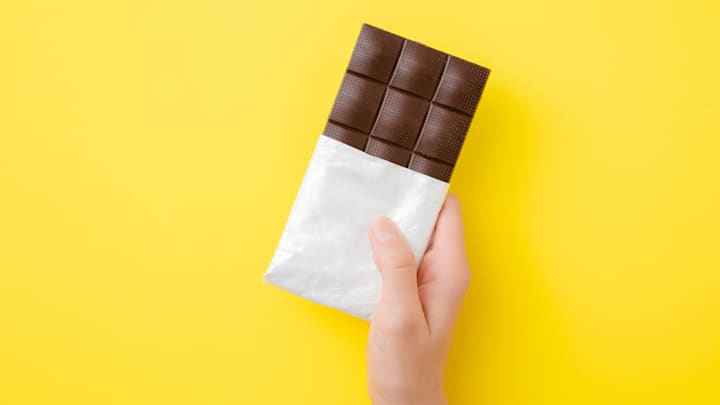Happy World Chocolate Day! In celebration of this most delicious holiday, let’s brush up on our chocolate knowledge.
1. There are multiple celebrations of chocolate each year.
July 7 is World Chocolate Day, a nod to when chocolate was said to have been first brought to Europe on July 7, 1550 (though a number of sources argue that it might have hit the continent’s shores as far back as 1504, thanks to Christopher Columbus). Official day or not, we do know that chocolate first arrived in Europe some time in the 16th century. There's also National Milk Chocolate Day on July 28, International Chocolate Day on September 13, and, of course, National Bittersweet Chocolate With Almonds Day on November 7.
2. White chocolate is not chocolate.
Because it doesn't contain cocoa solids or chocolate liquor, white chocolate isn't chocolate in the strict sense. But it does contain parts of the cacao bean—mainly cocoa butter.
3. The cacao bean is native to Mexico and both Central and South America.
There's even evidence that humans in what is now Ecuador were consuming cacao products around 5000 years ago.
4. Hot chocolate was the first chocolate treat.
Cacao was brewed in both Mexican and Aztec culture, though the result was nothing like today’s hot chocolate—it was a typically bitter concoction that was often used for ceremonial occasions like weddings.
5. Marie Antoinette loved hot chocolate (the modern kind).
Marie Antoinette didn’t just love cake; she also loved chocolate, and hot chocolate was frequently served at the Palace of Versailles.
6. Cacao was once used as currency.
The Aztecs loved and valued the cacao bean so highly that they used it as currency during the height of their civilization.
7. Spanish friars helped spread the love.
After cacao and chocolate were introduced to Europe, traveling Spanish friars took it to various monasteries, handily spreading it around the continent.
8. A pair of British confectioners invented solid chocolate.
The J.S. Fry & Sons shop concocted what they called “eating chocolate” in 1847 by combining cocoa butter, sugar, and chocolate liquor. This was a grainy, solid form of the treat.
9. Cadbury invented the heart-shaped box of chocolate.
If you ever needed to pick up a last-minute Valentine's Day gift from a gas station, now you know whom to thank.
10. It's said that Napoleon loved the stuff.
The popular story is that Napoleon was known to carry chocolate with him on military campaigns for an energy boost.
11. Baker's chocolate isn't just for baking.
Dr. James Baker and John Hannon founded their chocolate company—later called Walter Baker Chocolate—in the 18th century. That’s where the term “Baker's chocolate” comes from, not to denote chocolate that’s just meant for cooking.
12. On that note, German chocolate cake isn't from Germany.
The name comes from Samuel German, who invented a type of sweet baking chocolate for Baker's company in 1852 that became known as "German's chocolate." As NPR points out, the cake itself was the brainchild of a woman from Texas who used German's chocolate in the recipe and published the directions in a Dallas newspaper in 1957. The dish was originally known as "German's Chocolate Cake," but the apostrophe was lost along the way, resulting in the confusion.
13. Milton Hershey really was a candy king.
The Pennsylvania native may be best known for creating The Hershey Chocolate Company, but he got his start in candy long before hooking up with chocolate. He founded his first company, the Lancaster Caramel Company, when he was 30 years old.
14. Milk chocolate was invented in Switzerland.
Daniel Peter created the tasty treat in 1875—after eight years of trying to make his recipe work. Condensed milk ended up being the key ingredient.
15. Making chocolate is hard work.
Despite its regal background and revered status, the cacao bean doesn’t just magically turn into chocolate—it takes about 400 beans to make a single pound of the good stuff.
16. The United States military went to Hershey to make a special chocolate bar for troops.
In 1937, Captain Paul Logan of the U.S. Army met with Hershey's president, William Murrie, and chief chemist, Sam Hinkle, to craft government-approved chocolate bars to send to soldiers overseas in the event of a war. To get the recipe up to Uncle Sam's specifications, Logan required the company to meet four objectives: The bar had to weigh about four ounces, withstand high temperatures, be high in calories, and taste "a little better than a boiled potato," according to the Hershey Community Archives.
Why the part about the potato? They're called rations for a reason, and if the chocolate tasted too good, there was a fear that the troops would eat them in non-emergency situations. The end result was known as the "D Ration Bar," and it was a part of many of the supply packs given to soldiers during the D-Day invasion.
17. Most cacao is now grown in Africa.
Despite its Amazonian roots, most cacao—nearly 70 percent of the world’s supply—comes from Africa. Côte d'Ivoire is the largest single producer, providing about 30 percent of all the world’s cacao.
18. Cacao trees can live to be 100 years old.
That may sound impressive, but the tropical beauties only make viable cacao beans for just 25 years of their lifespan.
19. There are three main kinds of cacao.
Most modern chocolate comes from forastero beans, which are considered easy to grow—though the criollo and trinitario beans are believed to make much tastier chocolate.
20. Chocolate has a special melting point.
According to the Library of Congress, chocolate has a melting point between 86°F and 90°F, which is just below the human body temperature. That’s why your favorite candy bar melt will melt in your hands if you don't eat it fast enough.
This article was originally published in 2018; it has been updated for 2022.
